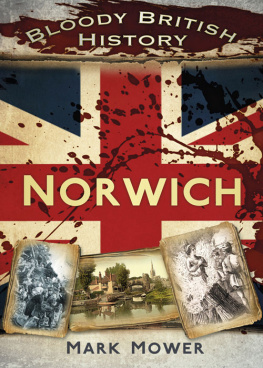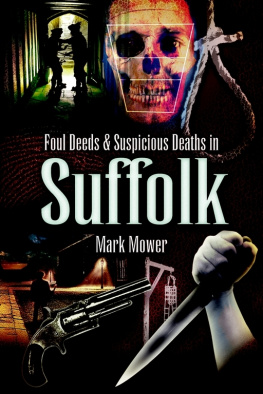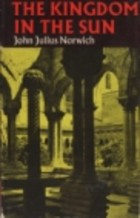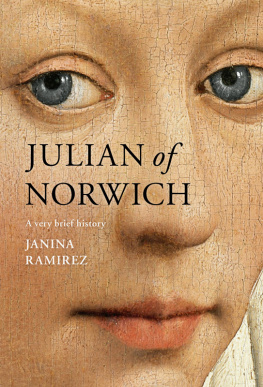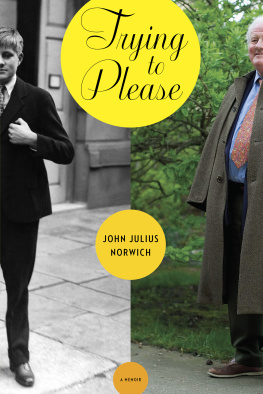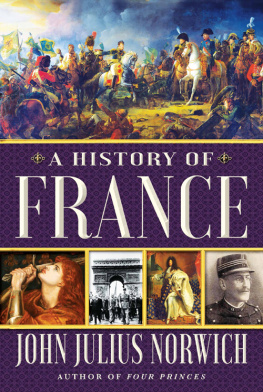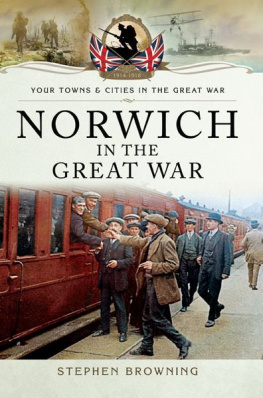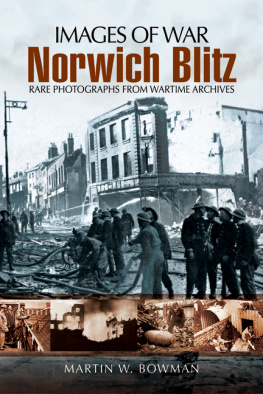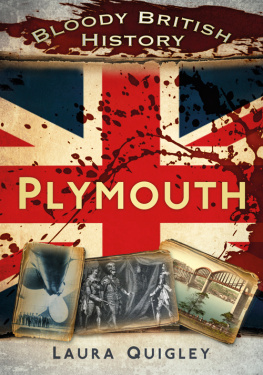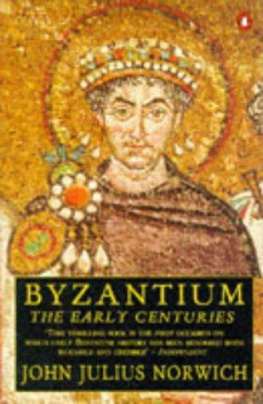
CONTENTS

INTRODUCTION AND
ACKNOWLEDGEMENTS
N ORWICH IS INDEED a fine and remarkable city. In George Borrows 1851 novel Lavengro, the character Jasper Petulengro stands on Mousehold Heath and reflects on the vista before him:
A fine old city, truly, is that, view it from whatever side you will; but it shows best from the east, where the ground, bold and elevated, overlooks the fair and fertile valley in which it stands. Gazing from those heights, the eye beholds a scene which cannot fail to awaken, even in the least sensitive bosom, feelings of pleasure and admiration.
In the thousand years of its history as an inhabited community, little has diminished that panoramic and uplifting view of Norwich. And through all of the crises and challenges of English history, it has shown itself to be resilient from Viking torchbearers to Nazi incendiaries, the city has not only survived, but has continued to flourish.
Norwich is the largest walled medieval city in England and has the greatest number of medieval churches in Northern Europe. Following a riot in 1274, it had the dubious distinction of being the only city to have its citizens excommunicated by a Pope a general absolution came from Rome two years later, when the spat between the clergy and city-dwellers was finally resolved.
Norwich is often noted for its pioneering and radical history. It launched the first English provincial newspaper in 1701 and was the first location in the UK to have a postcode. Its council was also the first local authority in the country to install a computer.
It would be wrong to suggest, however, that Norwich has not had its darker moments periods of history defined more by grisly deaths, grim diseases and gruesome destruction than any of its more positive achievements. In this climate has festered religious intolerance, murderous intent and lusts for power that might be said to have tarnished the citys reputation as a sophisticated, enlightened and urbane conurbation.
Such, then, is the nature of this condensed volume. It does not pretend to be a comprehensive or overly academic account of Norwichs past. The English historian Edward Gibbon once suggested that: History is indeed little more than the register of the crimes, follies and misfortunes of mankind. If that is the case, this book can be said to present a fair slice of the citys history, without all of the long-winded passages of an educational text. Either way, I hope that my lasting affection for the citys past comes through loud and clear.
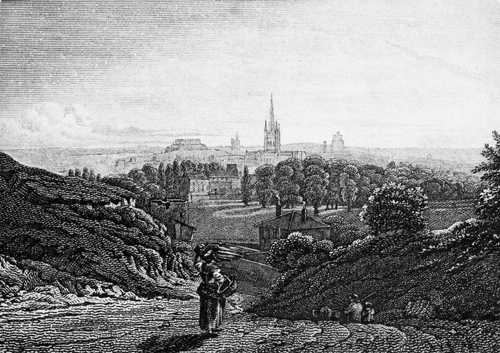
The view from Mousehold Heath in 1818.
A number of people helped me in researching and writing this book and I would like to express my thanks to the following for their kind assistance and invaluable support: Jonathan Plunkett, for use of some of the marvellous photographs of old Norwich taken by his father in the early part of the twentieth century; Clare Everitt, Picture Norfolk Administrator, for providing me with access to some of the unique images contained in Norfolk County Councils online database; and staff of the Norfolk Public Record Office of the Norwich Millennium Library for their knowledge and guidance on aspects of the research. Those photographs and illustrations that appear in the book uncredited are from my own camera or collection.
Finally, I would like to thank my wife Jacqueline and daughter Rosie for their continued encouragement and support.
Mark Mower, 2014
Norwich Plays Host to
Migrant Warmongers
I N THE AFTERMATH of the Roman invasion of Britain, it was to be the Germanic tribes of the Angles, Saxons, Frisians and Jutes that became the lifeblood of the East Anglian population, colonising large areas, establishing new settlements and cultivating the land. In their wake, the Vikings brought further influences to the cultural diversity of the East Angles, but not without fierce hostility from the incumbent tribes. This turbulent period of British history would see Norwich experiencing both the highs and lows of what the Scandinavians had to offer.
P ERIODIC V IKING R AIDS
The Vikings may have been peace-loving in their Scandinavian heartlands, but were one of many wandering tribes that were unable to curb their bloodlust when travelling overseas. In the late ninth century, the heathen warriors wreaked havoc on the Christian population of East Anglia, destroying churches and monasteries and levelling homes and villages.
Like earlier foreign invaders, the Norsemen from Sweden, Denmark and Norway used the easily navigable rivers like the Yare and Wensum to attack local settlements. And while the early raids were often isolated attacks by a single longship, larger Viking raids began in the year 866, the Anglo-Saxon Chronicle recording that: the same year came a large heathen army into England, and fixed their winter-quarters in East-Anglia, where they were soon horsed; and the inhabitants made peace with them.
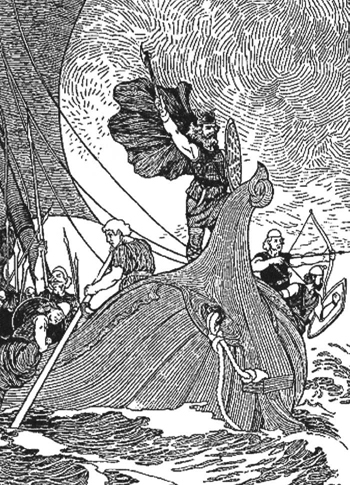
A Viking longship attacking England. (Victor R. Lambdin, from Viking Tales by Jennie Hall, 1902)
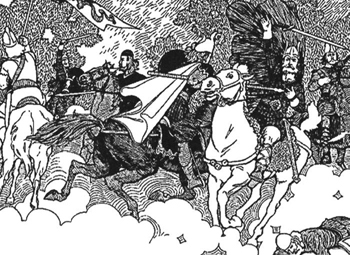
Viking warriors in battle. (Victor R. Lambdin, from Viking Tales by Jennie Hall, 1902)
T HE B LOODY V IKINGS
The peace was short-lived. As an independent kingdom, East Anglia was ruled at this time by the young King Edmund. He fought a brave, but ultimately unsuccessful, campaign to oust the invaders, who had consolidated their position in Thetford by the autumn of 869. Led by the fearsome Ivarr the Boneless, the large Viking army fought a pitched battle against Edmunds smaller band of followers, which left both sides with heavy losses but no immediate victory.
It is thought that King Edmund and his followers re-established their dishevelled army in the village of Hoxne in Suffolk, where they were later surrounded and slaughtered by the Norsemen. Edmund himself was taken prisoner and, when he refused to capitulate, Ivarr had his archers execute the Anglo-Saxon leader. Given the scarcity of historical records for the period, it is by no means certain that Hoxne was the place where Edmund died, and some have suggested that Hellesdon, on the outskirts of Norwich, may really have been the place of his demise.
A P ERIOD OF S ETTLEMENT AND P ROSPERITY
In the aftermath of the Treaty of Wedmore in 878, England experienced a period of relative peace for the next 100 years. Under the agreement between Alfred the Great of Wessex and King Guthrum of Denmark, the Vikings were able to share out the lands that they held in England known as the Danelaw which were still populated mainly by Anglo-Saxons. Guthrum also adopted the Christian faith.
It was during this time that the Scandinavian settlement of East Anglia began in earnest, with Vikings marrying into local Anglo-Saxon communities and becoming merchants, artisans and farmers in the rapidly growing and prosperous towns of Norfolk, Suffolk and Essex. One of these was Norwich, which by the early ninth century had achieved the status of a large urban burgh or fortified town with strong trading connections across Europe. By the end of the Viking era, it would have a population of between 5,000 and 10,000 inhabitants, making it the fifth largest town in England.
Next page
